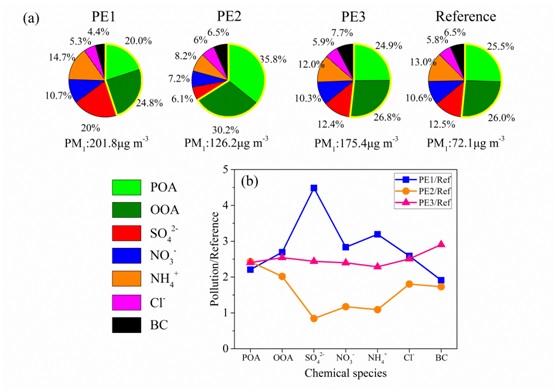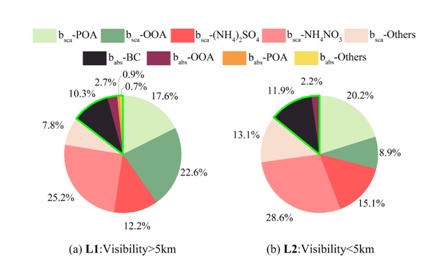Atmospheric aerosols affect the radiative and energy budgets of the atmosphere directly by scattering and absorbing solar radiation, and the scattering and absorption coefficient, are closely connected to the composition, size distributions, morphological characteristics, and mixing state of the aerosol. To date, the relationship between the chemical components and optical properties has been investigated widely, but most of those studies relied on daily filter-based measurements and IMPROVE formula, and thus, it was difficult to follow the optical properties of the aerosol during the evolution of pollution events. Therefore, it is more effective to use high time-resolution data to analyze the pollution formation and evaluate the contribution of chemical components to scattering and absorption coefficient.
For this study, an intensive campaign was conducted at Xi'an during winter to measure aerosol chemical composition and aerosol light scattering and absorption at high time-resolution. During three pollution episodes (Fig.1), the PM1 mass loadings were1.8–2.8 times larger than during the reference days. The PE1 was characterized by a strong contribution of SIA (secondary inorganic aerosols, 45.4%) to the PM1 mass, and that was likely caused by the aqueous-phase oxidation of gas precursors. Unlike the two other PEs, OA (organic aerosol) contributed the largest percentage (66.0%) of the PM1 mass during PE2, and the emission of POA was important during the evolution of that pollution episode. The chemical composition of the aerosol during PE3 was similar to that on the reference days, but the concentration were~2-fold higher due to meteorological conditions unfavorable for the dispersal of pollutants. This revealed that primary emissions and aqueous-phase oxidation were both essential in evolution of the pollution episodes during winter in Xi’an.
The calculated mass scattering efficiency (MSE) for PM1 (4.1±0.1 m2·g-1) was twice thanPM2.5-1(2.1±0.1 m2·g-1), and the estimated mass absorption efficiency (MAE) for PM1was 0.76±0.03 m2·g-1, which was five-fold higher than that for PM2.5-1(0.15±0.03 m2·g-1). It indicated stronger ability of light extinction for the small particles (diameters<1 μm) than larger ones at visible wave lengths. The chemical extinction apportionment showed that OA and SIA were two major contributors of extinction coefficient, whereas the contribution of SIA to extinction under LV(low visibility) condition exceeded that of OA (31.3%), which indicated secondary inorganic aerosols (mainly NH4NO3) played an especially important role in visibility degradation when theair pollution was severe (Fig.2). The results of this study will help us understand the changes in aerosol populations and their optical properties under severe pollution conditions.
This work was published in Journal of Environmental Management.

Fig.1.(a) Arithmetic mean mass contributionof primary organic aerosol (POA), oxygenated organic aerosol (OOA), SO42-,NO3-, NH4+, Cl-, and black carbon (BC) to PM1 mass during three pollution episodesand on reference days (areas outlined withthick yellow lines represent the organicaerosol); (b) Enhancement ratios of PM1 chemical species concentrations betweeneach pollution episode versus referencedays. PE1, PE2, and PE3 represent pollutionepisodes.(Image by WANG, et.al)

Fig.2 Contributions of primary organicaerosol (POA), oxygenated organic aerosol(OOA), (NH4)2SO4, NH4NO3, black carbon(BC), and other materials (others) to lightextinction coefficients under different visibilityconditions (Area outlined in greenrepresents the absorption coefficient). Bscatand babs represent the light scattering andabsorption coefficients, respectively.(Image by WANG, et.al)
Contact: Bai Jie, Institute of Earth Environment, Chinese Academy of Sciences, Xi'an, China. Email: baijie@ieecas.cn
 © 2015 Institute of Earth Environment,CAS
© 2015 Institute of Earth Environment,CAS Address:No. 97 Yanxiang Road, Xi'an 710061, Shaanxi, China

 Location :
Location :